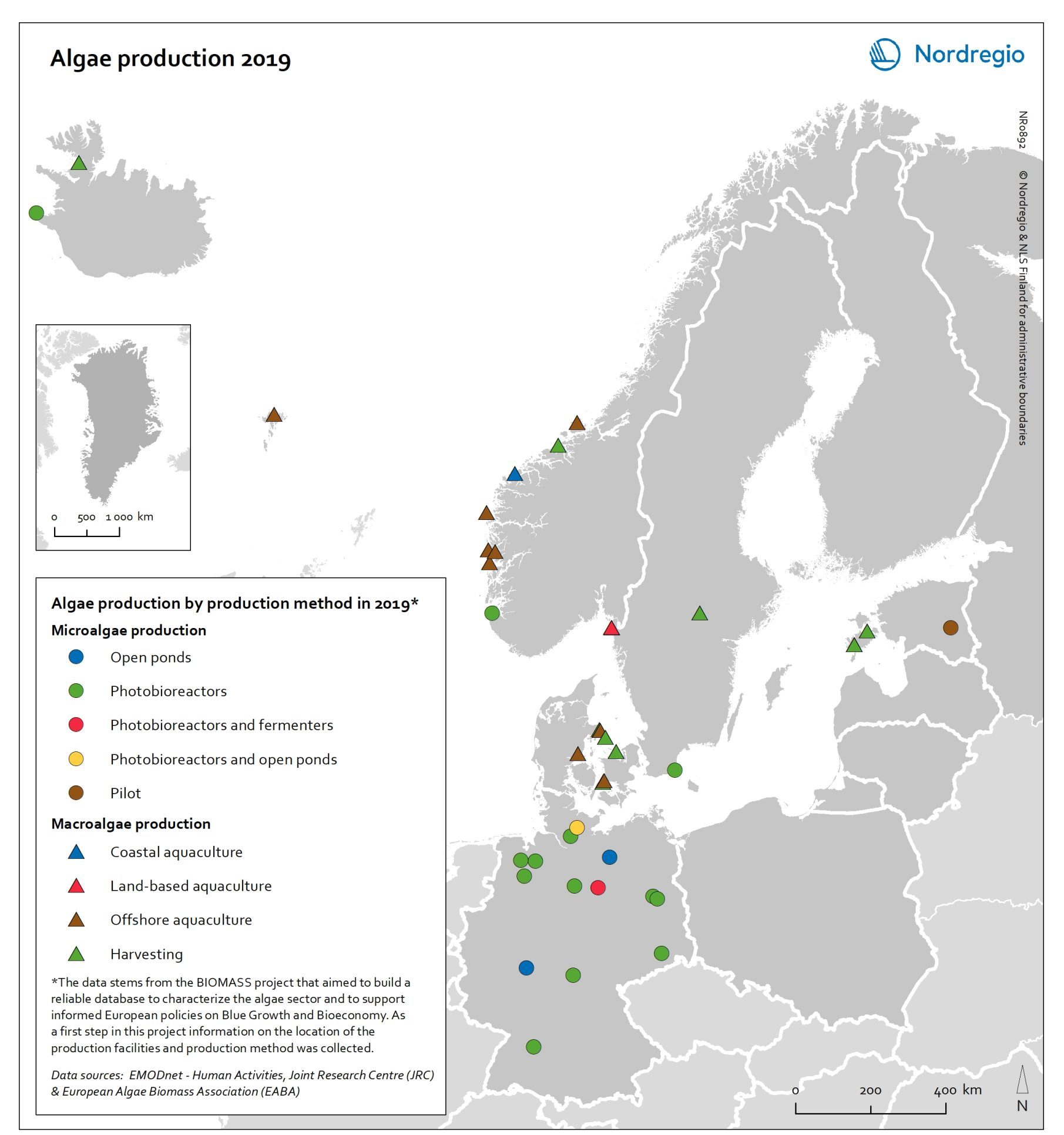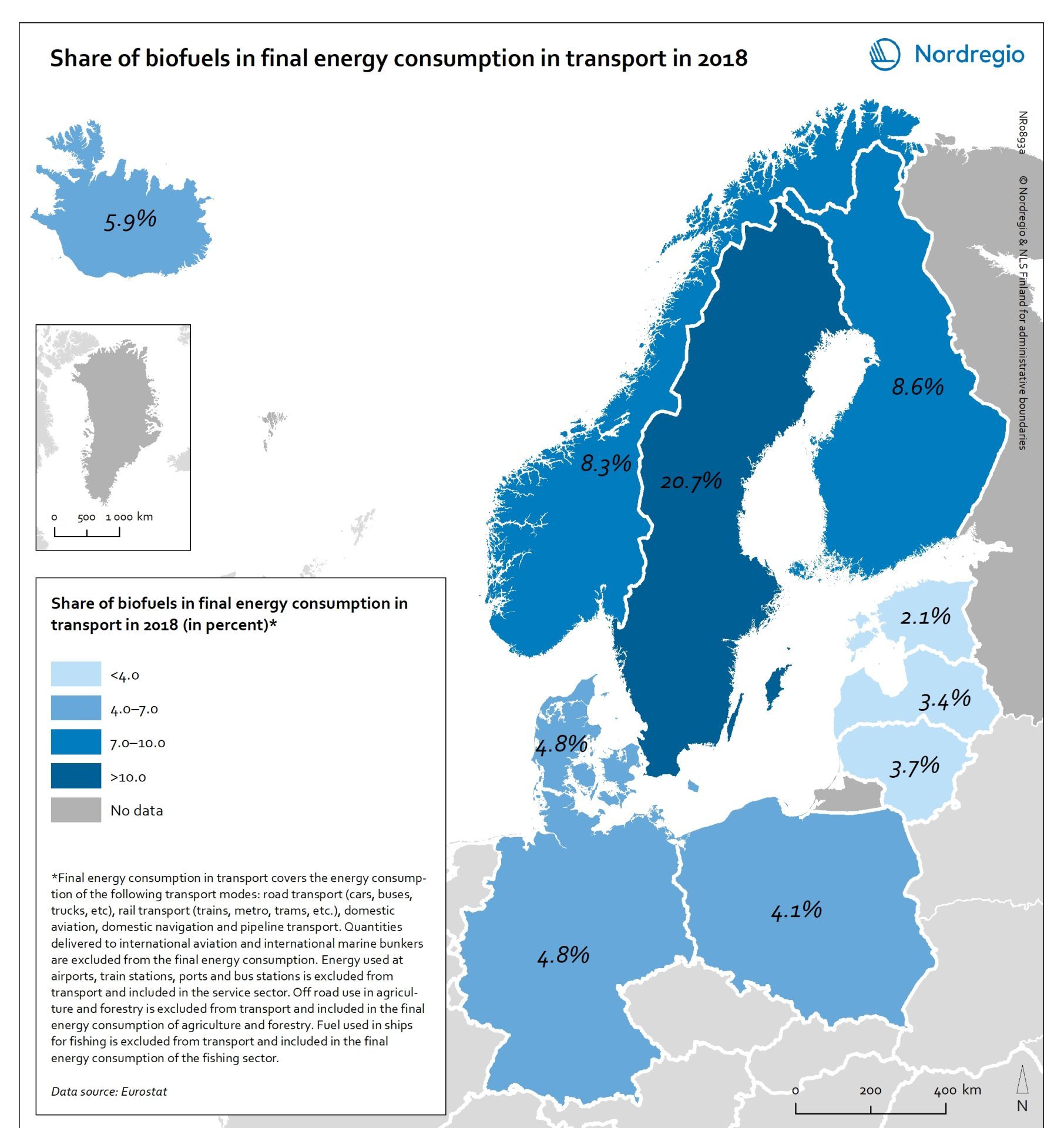75 Maps

Algae production in 2019
This map shows location of algae production by production method in the Nordic Arctic and Baltic Sea Region in 2019 Algae and seaweeds are gaining attention as useful inputs for industries as diverse as energy and human food production. Aquatic vegetation – both in the seas and in freshwater – can grow at several times the pace of terrestrial plants, and the high natural oil content of some algae makes them ideal for producing a variety of products, from cosmetic oils to biofuels. At the same time, algae farming has added value in potential synergies with farming on land, as algae farms utilise nutrient run-off and reduce eutrophication. In addition, aquatic vegetation is a highly versatile feedstock. Algae and seaweed thrive in challenging and varied conditions and can be transformed into products ranging from fuel, feeds, fertiliser, and chemicals, to third-generation sugar and biomass. These benefits are the basis for seaweed and algae emerging as one of the most important bioeconomy trends in the Nordic Arctic and Baltic Sea region. The production of algae for food and industrial uses has hence significant potential, particularly in terms of environmental impact, but it is still at an early stage. The production of algae (both micro- and macroalgae) can take numerous forms, as shown by this map. At least nine different production methods were identified in the region covered in this analysis. A total of 41 production sites were operating in Denmark, Estonia, the Faroe Islands, Iceland, Norway, Germany, and Sweden. Germany has by far the most sites for microalgae production, whereas Denmark and Norway have the most macroalgae sites.
2021 December
- Arctic
- Baltic Sea Region
- Nordic Region
- Others

Change in share of biofuels in transport from 2010 to 2018
This map shows change in share of biofuels in final energy consumption in transport in the Nordic Arctic and Baltic Sea Region from 2010 to 2018. Even though a target for greater use of biofuels has been EU policy since the Renewable Energy and Fuel Quality Directives of 2009, development has been slow. The darker shades of blue on the map represent higher increase, and the lighter shades of blue reflect lower increase. The lilac color represent decrease. The Baltic Sea represents a divide in the region, with countries to the north and west experiencing growth in the use of biofuels for transport in recent years. Sweden stands out (16 per cent growth), while the other Nordic countries has experienced more modest increase. In the southern and eastern parts of the region, the use of biofuels for transport has largely stagnated. Total biofuel consumption for transport has risen more than the figure indicates due to an increase in transport use over the period.
2021 December
- Arctic
- Baltic Sea Region
- Nordic Region
- Transport

Share of biofuels in transport in 2018
This map shows the share of biofuels in final energy consumption in transport in the Nordic Arctic and Baltic Sea Region in 2018. There has been considerable political support for biofuels and in the EU, this debate has been driven by the aim of reducing dependency on imported fuels. For instance, 10 per cent of transport fuel should be produced from renewable sources. The darker shades on the map represent higher proportions, and the lighter shades reflect lower proportions. As presented by the map, only Sweden (20.7%) had reached the 10 per cent target in the Nordic Arctic and Baltic Region in 2018. Both Finland (8.3%) and Norway (8.3%) were close by the target, while the other countries in the region were still lagging behind, particularly the Baltic countries.
2021 December
- Arctic
- Baltic Sea Region
- Nordic Region
- Transport








Smart specialisation domains in Swedish regions
This map gives an overview of the S3 focus areas in the Swedish regions in 2019. The major S3 domains in Sweden shown in the map provide a good overview of the key specialisation areas in Sweden. It is possible, for example, to check which Swedish regions have “green”, “sustainable”, “environment” at their smart specialisation domains (marked in green in their respective infoboxes for the domains in the figure). The information illustrated in the map can assist Swedish regions when they are considering opportunities for S3 synergy and co-operation with each other. In Sweden, the Swedish Agency for Economic and Regional Growth (Tillväxtverket) is a central actor in assisting regions in their work with smart specialisation. Tillväxtverket promotes opportunities for cooperation between the Swedish regional S3 processes and provides relevant information and learning seminars related to S3. Read the digital publication here.
2020 February
- Economy
- Research and innovation
- Sweden

Higher educational institutions in the Arctic
The map shows universities and other educational institutions on post-secondary and tertiary level located in the Arctic. The red circles indicate a location of a university, college, or campus areas within the Arctic. The size of the circle corresponds to the number of educational institutions in a specific location. There is a high density of educational education institutions around Anchorage (Alaska), in Iceland, the Faroe Islands and the Arctic Fennoscandia (see zoom-in maps). In the Yukon (Canada), the Yukon College is the main educational institution, which has several campus areas across the region. In the Russian Arctic the largest centres with higher educational institutions are in Murmansk, Naryan-Mar (Nenets), Nizhnevartovsk (Khanty-Mansi), Salekhard (Yamalo-Nenets), and Yakutsk (Sakha).
2019 March
- Arctic
- Others
- Research and innovation

Natural population change in the Arctic
The map shows the annual natural population change rates in the Arctic subregions between 2013 and 2017. The blue tones indicate a positive change: subregions where the number of live births exceeds the number of deaths. The yellow colour indicates no or little change: subregions where the difference between births and deaths are close to zero. The red tones indicate negative change: subregions where the number of deaths exceed the number of live births. In the Artic the annual average natural population change rate was 0,66% between 2013 and 2017. The natural population change was positive especially in the Canadian Arctic, Alaska (USA), Greenland as well as in Yamalo-Nenets, Khanty-Mansi and in Sakha regions (Russian Federation). Natural population decline was the strongest in the Nordic Arctic, as well as in Murmansk, Magadan, and Kamchatka (Russian Federation).
2019 March
- Arctic
- Demography

Tertiary educational attainment level in the Arctic
The map shows the percent of individuals aged 25-64 with tertiary education as the highest attainment level in the Arctic regions in 2017. Tertiary education corresponds to International Standard Classification of Education (ISCED) 2011 levels 5-8, which represent bachelor or equivalent and all higher attainment levels. The dark green tones show regions where more than 30% of individuals attained tertiary education as highest level. The light green tones show regions where less than 15% of individuals attained tertiary education as highest level. Highest shares of working aged population with tertiary education were found in Troms (Norway, 43,8%) and Iceland (42,5%). All other Nordic Arctic regions as well as Yukon (Canada, 33,3%) and in some regions in Alaska (USA) had high shares of highly educated people. Northern Quebec (Canada) had the lowest share of working aged population that attained tertiary education (13,0%).
2019 March
- Arctic
- Demography
- Economy

Upper secondary educational attainment level in the Arctic
The map shows the percent of individuals aged 25-64 with upper secondary education as highest level attained in 2017 in Arctic regions. The upper secondary education corresponds to International Standard Classification of Education (ISCED) 2011 levels 3-4. The dark blue tones show regions where more than 80% of individuals attained upper secondary education as highest level. The lightest blue tones show regions where less than 60% of individuals attained upper secondary education as highest level. Among the working age population, the number of individuals with upper secondary education was the highest in Alaska (USA, over 90%). Individuals with upper secondary education attainment level was also high – above 80% – in the Yukon and Labrador (Canada), Norrbotten (Sweden), and in Lappi (Finland). The lowest share of individual with upper secondary education was in Greenland (45,6%), Chukotka (Russian Federation, 58,4%) and in Nunavut (Canada, 59,1%).
2019 March
- Arctic
- Demography

Labour force participation rate in the Arctic
The map shows the regional labour force (active population) as share of total population in the Arctic regions in 2016. The active population includes all persons (aged 15 years old and over) with at least one current paid job or searching for one. The dark green tones show regions with high participation rates and correspondingly light green tones show regions with low participation rates. The Russian Arctic regions of Chukotka (83,6%), Yamalo-Nenets (78,0%), and Magadan (76,1%) had the highest participation rates. The lowest participation rates were in Lappi (Finland, 53,3%) and in Nordland (Norway, 59,9%).
2019 March
- Arctic
- Economy
- Labour force

Unemployment rate in the Arctic
The map shows unemployed persons as share of the labour force (aged 15 years old and over) in the Arctic regions in 2016. The dark orange tones show regions with high unemployment rates and correspondingly light orange tones show regions with low unemployment rate. Nunavut and Newfoundland and Labrador (Canada, 14,0% and 13,4%, respectively) had the highest unemployment rates. The unemployment rate was the lowest in Finnmark, Nordland, and Troms (Norway, 2,6%, 3,3%, and 3,3%, respectively), in the Faroe Islands (3,3%), in Iceland (3,0%), as well as in three Russian Arctic regions: Magadan (3,1%), Yamalo-Nenets (3,1%), and Chukotka (3,2%). The unemployment rate in the Arctic regions mostly follows the national averages.
2019 March
- Arctic
- Economy
- Labour force

Part-time employment incidence in the Arctic
The map shows the share of the part-time employees over total employment in the Arctic regions in 2014. Part-time workers are considered as persons (aged 15 years old and over) who are working less than 30 hours per week. The dark blue tones show regions with high part-time employment incidence and correspondingly light blue tones show regions with low part-time employment incidence. The three Arctic regions of Norway had the highest part-time employment incidence: Nordland (59,5%), Troms (56,3%), and Finnmark (56,0%). The Russian Arctic regions of Yamalo-Nenets (0,9%), Khanty-Mansi (2,5%), and Chukotka (3,4%) had the lowest part-time employment incidence.
2019 March
- Arctic
- Economy
- Labour force



